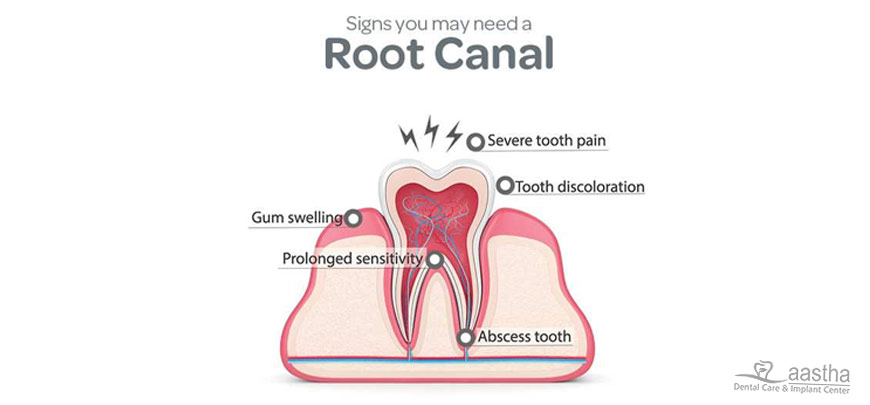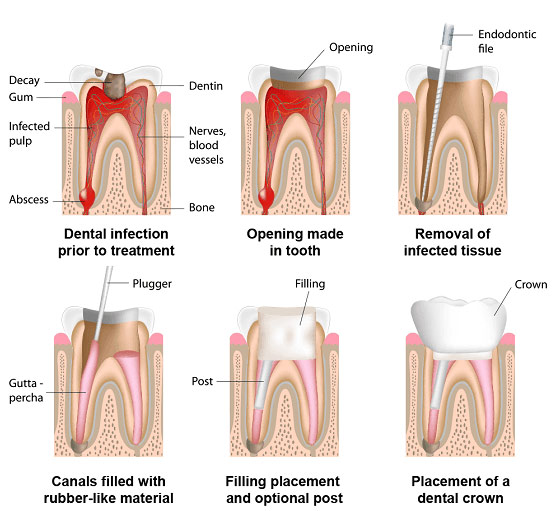Working Time
- Mon-Fri 08:00 - 20:00
Saturday 08:00 - 18:00
Contact Info
Root Canal Treatment
What is RCT or Root Canal Treatment?
Whenever we think of a dentist, one of the first things that comes to mind is ‘toothache’ and ‘root canal’. Infact, a large majority of the people fear root canal treatment as they believe it is a painful procedure.

But, how many of us really know and understand what a root canal is how and why a root canal treatment is performed?
Did you know that our tooth is made up of 3 layers?
- Outer enamel.
- Middle dentine.
- Inner pulp.
It is this pulp layer that keeps our tooth alive as it contains blood vessels and nerves.
When tooth decay begins, it slowly eats away the enamel, dentine and if left untreated, then reaches the pulp.

The treatment for tooth decay depends upon the extent of its spread:
- When the decay is limited to the enamel and dentine layers, it can be treated by a filling.
- However, when the decay reaches the pulp layer, it needs root canal treatment. The decay reaching the pulp is one of the main reasons for tooth pain and pulp infection.
Root Canal Treatment is a multi-step procedure that involves:
- Removal of the infected and inflamed pulp
- Cleaning the root canals and disinfecting them
- Filling the canals with an inert material and sealing them
- A post root canal crown or cap
When Do You Need a Root Canal Treatment?
Now that we know why a root canal procedure is done, the next question that comes to mind is when do you need one?
Are there any signs and symptoms that indicate one may require a root canal treatment?

Yes, there are some common situations that demand a root canal treatment and these are:
- Teeth with deep decay
- Broken or cracked teeth
- Teeth with gum diseases
- Failed dental fillings
- Teeth that have suffered a trauma
Symptoms that most people are likely to experience that may indicate the need for a root canal treatment:
A large number of patients who report to the dentist with a swelling are treated by root canal procedure.
Procedure of a Root Canal Treatment
When you hear the word ‘root canal treatment’, apart from pain, another question that comes to mind is “How many visits does a root canal take?”

Well as mentioned earlier on, root canal treatment is a multi-step procedure and it usually takes 1-2 sittings, but can take longer based on the condition of the tooth and the level of infection.
Here is what a root canal treatment procedure entails:
- X-ray
- Removal or decay and preparing the cavity
- Removal of infected pulp, drainage of any pus from underneath the tooth
- Cleaning, disinfecting and preparing the canals
- Sealing the canals with inert material and a sealant
- Post-root canal filling and crown
X-ray is indispensable for a root canal procedure and is the first step as well. In order to determine the cause of your pain and the extent of decay, one of the first things your dentist does is take an x-ray of the affected tooth.
After an x-ray is taken, in most cases, the next step is to inject a local anaesthetic to ensure you have a painless procedure. In some cases, however, since the patient is asymptomatic or the tooth is completely dead and painless, local anaesthesia may be omitted.
The next step in root canal treatment is the removal of all the decay that can be seen and preparing a cavity in the tooth to access the inner pulp easily.
Once straight-line access has been obtained, the infected and inflamed pulp is removed completely.
In some cases, the pulp may have disintegrated and only specks of it remain, which can be washed out by using a saline solution in the canals.
In cases where there is pus accumulation beneath the root, accessing and removing the pulp facilitates drainage of pus and provides immediate relief to the patient.
Once the pulp has been removed and the canals are disinfected with saline solution, the canals are cleaned and shaped to be able to accommodate the filling material.
In ideal cases, the canals can be sealed with the inert rubber-based material in the same sitting itself. Such a root canal treatment is called as single-sitting root canal.
However, in practise, most cases require a gap of 3-5 days before the canals can be permanently sealed. In the interim, the dentist places a calcium-based medication to allow the inflamed tissues to heal.
Once the canals are ready to be sealed, rubber-based cones are placed into the canals and sealed. These cones are inert in nature and do not dissolve in saliva or blood and thereby, prevent re-infection of the tooth.
Once the canals have been sealed, it is time to restore the decayed crown portion of your tooth with tooth filling material. After this, the tooth crown is shaped for the placement of a cap that will strengthen the tooth.
How Painful is the Rct of teeth?
Root channel methods have the notoriety of being difficult. All things considered, the vast majority report that the method itself is not any more agonizing than having a filling put. In this case, endodontists offer anesthesia in the area to numb it and perform the rct of teeth calmly and patiently. Usually patients don’t experience pain during the treatment but once the rct of teeth is done, after the injection starts losing it affects pain starts occurring.
Is throbbing pain after root canal normal?
Pain and Discomfort after the root canal treatment is normal for a few days. As our body heals, the area around the tooth can feel a bit sore and tender, which is why it is normal to experience mild to moderate pain for a few days after root canal treatment.
Remedies to follow after the root canal treatment-
Once the Root canal treatment is done there are a few things to follow and they are:
- Avoid eating hard food for a few days.
- Try eating soft food like ice-cream, soups and fruit juices
- Start brushing your teeth twice a day
- Start reducing the amount of sugary food in your daily diet.
However, if the root canal treatment pain is intense or if the pain persists or if there is a swelling, then consult your dentist immediately.
Is Crown necessary after root canal?
In this process, a large part of the tooth’s original structure is removed or cut, it has to be reinforced with a Cap or Crown. The dentist cuts the tooth structure after completion of the root canal treatment to form a seat for the cap or the crown. The tooth structure is removed with dental bur. It is a painless process.
What are the different types of crowns for teeth?
The patient can choose the type of crown that he or she wants after the root canal treatment. There are different types of crowns depending on the material that is used for making the crown. The most common crown that is used is a Porcelain fused to metal crown (PFM). A PFM crown is one of the cheapest alternatives after metal crown but it looks similar to the natural tooth due to the white color of the porcelain coating on the metal tooth structure. However, Zirconia crowns are best suited in most cases since zirconia has the best aesthetics as well as strength combination which will be the perfect replacement for the natural tooth. A root canal treatment with a Zirconia Cap on top of it is the perfect solution for a patient who is diagnosed with a cavity that requires a root canal treatment.
Aastha Dental Care & Implant Centre is amongst the best dental clinics in Ahmedabad, Gujarat, India which specializes in carrying out many dental treatments, such as root canal treatment.
Root canal treatment is amongst the most efficient treatment procedures which can reduce dental ache and also save a very decayed tooth. In this process, the dental surgeons remove affected nerves and also pulp of the tooth carefully and then simply seal this. If this problem remains untreated, then there are possibilities that the neighbouring teeth could also get infected.
Tooth root canal treatment is executed in three steps, and many of the dental surgeons perform this process in three different sessions. But due to the specialised root canal dentists, staff and also superior services available at Aastha Dental Care & Implant Centre, this RCT treatment procedure can be completed in just a single session. The dentist first administers local anaesthesia to your treatment area to lower root canal treatment pain as well as make the spot numb. Then a tiny hole is created on the surface of the tooth to remove the affected nerves and dead pulp. Next, the root canal dentists at Aastha Dental Care & Implant Centre clean and reshape the particular decontaminated hollow area. This hollow empty canal will be lastly filled up with a dental filling to seal off the tooth root canal completely, thus completing the root canal treatment. Immediately after this, the tooth is absolutely dead and has no sensation. Finally, in order to safeguard this lifeless brittle tooth, a crown might be placed on the dead tooth in order to ensure that the patient can make use of the tooth just like before. The root canal treatment price widely varies individually for each person depending on the seriousness of the condition. But Aastha Dental Care & Implant Centre offers some of the best root canal treatment costs in Ahmedabad. Thus, the next time if you are planning to have an RCT treatment, think about Aastha Dental Care & Implant Centre as your first choice to solve your dental complications and keep smiling.

